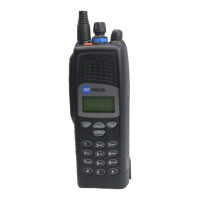TP9100 Service Manual Transmitter Fault Finding 219
© Tait Electronics Limited May 2005
Trans mit Tes ts
The following points need to be borne in mind when carrying out transmit
tests:
■ secure main board
■ ensure proper antenna load
■ limit duration of transmit tests
■ protect against accidental transmissions
■ avoid thermal and RF burns
These points are discussed in more detail below.
Secure Main Board Before conducting any transmit tests, ensure that the main board is
adequately secured in the chassis. This is essential if overheating of the radio
is to be avoided.
Ensure Proper
Antenna Load
The radio has been designed to operate with a 50Ω termination impedance,
but will tolerate a wide range of antenna loading conditions. Nevertheless,
care should be exercised. Normally the RF connector on the main board
will be connected to the RF communications test set as shown in Figure 4.2
on page 87. But for those tests where this connection is not necessary, a 50Ω
load may be used instead. Do not operate the transmitter without such a load
or without a connection to the test set. Failure to do so might result in
damage to the power output stage of the transmitter.
Limit Duration of
Trans mit Tes ts
After setting the frequency and power level (if necessary), enter the CCTM
command 33 to perform a transmit test. This command places the radio in
transmit mode. After completing the measurement or check required,
immediately enter the CCTM command 32. This command returns the
radio to the receive mode. Restricting the duration of transmit tests in this
way will further limit the danger of overheating. The reason for this
precaution is that the transmit timers do not function in the CCTM mode.
Protect Against
Accidental
Transmissions
Under certain circumstances the microprocessor can key on the transmitter.
Ensure that all instruments are protected at all times from such accidental
transmissions.
Avoid Thermal
and RF Burns
Avoid thermal burns. Do not touch the PA body when the transmitter is or
has been operating. Avoid RF burns. Do not
touch the antenna connector
while the transmitter is operating.

